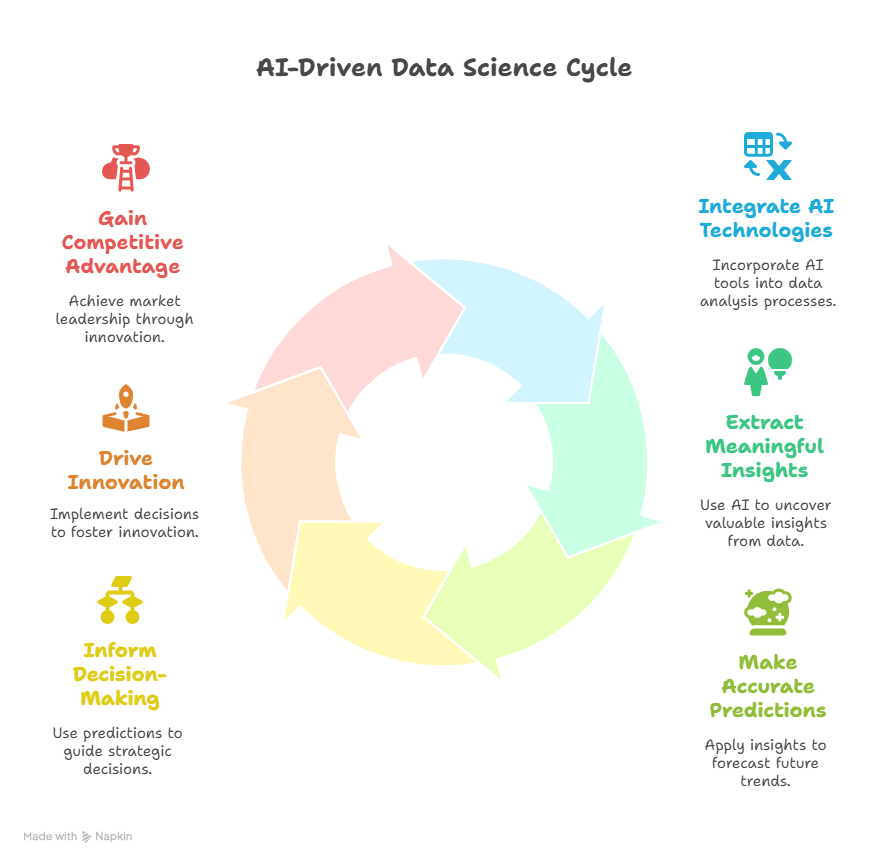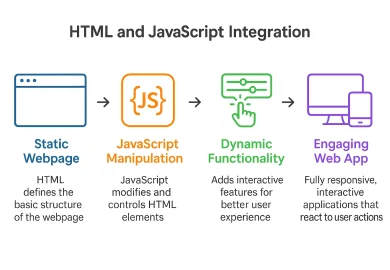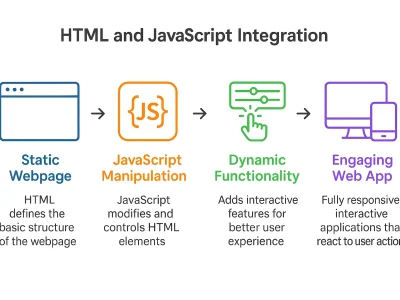Introduction
The rapid pace of change in the technological landscape necessitates the development of models, formulations, and solutions that address the challenges of the increasingly technological Artificial Intelligence (AI) and Data Science era across various areas of our activities. Now, with AI, data scientists can derive value and predict more accurately and efficiently at scale than ever before. AI’s role in data science. Data is now being used to drive decisions and business, and AI is key to what makes data valuable. The convergence of AI and data science is not only transforming workflows, but it is also equipping businesses of all kinds to adopt new approaches to decision-making, optimize for efficiency, and achieve better results.
This blog explores the potent intersection of AI and Data Science. The discussion will then focus on how AI has enhanced classic data science techniques, as well as the current state of the market and various AI tools and technologies. Additionally, it will explore how different industries are achieving success by incorporating AI into their data science pipelines. We will also discuss the challenges faced by businesses, including ethical considerations, and provide guidelines for successfully integrating AI-driven data science into your own business.
Understanding AI in Data Science
AI enhances data science by automating analysis, processing large datasets faster, detecting complex patterns, and delivering more accurate, scalable results.
Traditional vs AI-Powered Data Science
For years, standard data science was built on statistical models and human intuition to parse and make sense of datasets. Data scientists manually cleansed data, executing algorithms and running analyses shaped by their expertise and insight. These approaches do work in practice, but quite slowly, and now large amounts of statistical data need human labelling.
AI-powered data science employs advanced machine learning (ML)and deep learning (DL) techniques to automate much of the data analysis. AI can now be used to process data of any type and scale at incredible speeds, identify complex patterns, and even predict events in real-time. Machine learning models can be used to discover relationships between variables, and deep learning algorithms can learn and process unstructured data, such as images, videos, and text, that traditional strategies struggle to handle.
What is AI’s role in data science? AI augments the capacity of data science by automating mundane tasks and accelerating data processing, while also enabling more precise and reproducible results.
Milestones in AI-Data Science Integration
The process of combining AI and data science started 10 years ago, when we saw the first machine algorithms that could analyze large sets of data. At first, AI was employed for the automation of classification and clustering tasks. The next breakthrough followed in the form of deep learning, which permitted machines to identify far more complex patterns in data, be it an image or spoken language. Natural language processing (NLP) later brought AI closer to addressing practical issues, similar to industry challenges in text-heavy industries like law, finance, and customer support.
With the convergence of AI technology, the significance of AI in data science workflows has increased. Doing data analysis with artificial intelligence (AI) has evolved from science fiction to science fact over recent years; convoluted models are part of nearly every layer of data processing: data collection, pre-processing, model building, deployment, and even monitoring. Besides, cloud computing has allowed companies to ramp up AI models fast enough, to the extent that even small companies can now adopt AI.
Current State of AI Adoption
Artificial intelligence is no longer a futuristic fantasy, but is a key part of modern-day data science pipelines. It is no wonder that more than 60% of businesses across various sectors currently use AI in data analysis. From automating mundane tasks to offering real-time decision support, AI is at once making data science faster and more efficient, as well as more open and accessible. Employers in all industries, though, are at different stages of embracing remote work. For example, industries like finance, healthcare, and e-commerce have embraced AI to a great extent, but others, such as government and education, are just starting the journey of incorporating AI into their business processes.
The widespread availability of AI toolkits, open-source libraries, and cloud-based services is lowering the barrier for companies to add AI to the mix. And as AI is driving ahead, perhaps we will see AI’s influence in data science continue to become even more profound in the coming years
Key AI Technologies Transforming Data Science
AI runs on several technologies that allow data scientists to perform tasks with accuracy and efficiency. The following are the main artificial intelligence technologies that are shaping the future of data science:
Machine Learning & Deep Learning
ML is considered the base of AI in data science. By integrating algorithms, machines can be informed by the data and improve performance. Here we pack in a single sentence a lot of information about these algorithms – they can automatically fit to data and find patterns in your data. (disposing/fits) themselves to your data automatically and find patterns in your data automatically, and it is because of them being able to fit(discarding/fits) patterns that they are automatically sufficient to perform tasks such as classification, regression, and clustering. For example, a machine learning model can analyze customer data to forecast future purchasing patterns or identify fraudulent financial transactions.
One of the subsectors of machine learning is deep learning (DL), which is based on deep (multilayer) neural networks being able to extract more complex features in the data. Deep learning models are widely used in various applications, including image recognition, natural language processing, and speech recognition. Emulating the human brain to process information, deep learning algorithms interpret and extract generalization (or meaning) from unstructured data, including images, text, and audio, with impressive accuracy.
Automated Machine Learning (AutoML)
AutoML is a game-changer in democratizing AI. AutoML automatically selects, trains, and optimizes machine learning models. AutoML enables companies to create their own machine learning models without requiring deep expertise in the field. These are programs that one writes for the express purpose of automatically trying every sort of algorithm, cross-validating in different ways, and picking the best one.
AutoML: These tools can significantly reduce the time and costs associated with developing machine learning models, enabling enterprises to adopt new AI-driven applications quickly.
Natural Language Processing (NLP)
Natural Language Processing is an area of artificial intelligence with a focus on the interactions between computers and human language. Through NLP, data scientists can process large volumes of unstructured text data, including emails, social media posts, customer reviews, and other similar sources. This is very useful for areas such as marketing, customer service, and even healthcare.
With NLP, companies can parse what customers are thinking, pull pieces of information out of legal documents, assist in building chatbots for customer service, and even generate prose they never wrote. One use case of NLP algorithms is creating language translation apps, speech recognition systems, and automatic text summarisers.
Computer Vision
It is core AI technology that allows computers to “see and understand” visual information — everything from photographs and videos to patterns and objects. Applications of computer vision are varied in healthcare, factory automation, automotive and entertainment, for example.
In health care, for example, AI-powered computer vision is used to interpret medical images (such as X-rays and MRIs) to look for early signs of diseases such as cancer. Computer vision is also applied in industry to check the quality of products. For example, in automotive, computer vision is used to help enable an autonomous car to “see” and “understand” the objects around it, such as road signs, pedestrians, or vehicles.
AI-Powered Data Science Products and Platforms
Several tools and platforms have emerged to simplify the application of AI to businesses’ data science processes. These solutions can automate mundane tasks, deliver insightful analysis, and enable businesses to expand their AI efforts.
Cloud-Based AI Platforms
AI platforms in the cloud, such as Google Cloud AI, Microsoft Azure, and Amazon Web Services (AWS), provide businesses with the infrastructure and tools necessary for creating and executing AI models as part of their broader IT platform. These provide a wide selection of pre-canned AI services, including machine learning models, natural language processing utilities, and computer vision functions. Cloud-based platforms enable companies to operate without maintaining on-site hardware, instead paying for the computational power they use.
Cloud-based platforms enable companies to operate without maintaining on-site hardware, instead paying for the computational power they use. IBM AI also provides cloud-based AI platforms that help businesses integrate AI into their workflows, offering pre-trained models and advanced analytics capabilities.
Open Source AI Tools
Popular open-source applications among data scientists and developers include TensorFlow, PyTorch, and Scikit-learn. These libraries are powerful machine learning frameworks for designing your AI models. Open-source tools are highly configurable and can be tailored to fit various use cases, making them ideal for businesses that require full control over their AI models. Moreover, all these tools come with large communities of active users who are constantly implementing improvements and providing support to users.
Emerging AI Tools
AI is constantly evolving, and new tools for data scientists are emerging on the market. Some of the most innovative tools are AI-based data visualization platforms, automated feature engineering platforms, and intelligent data quality evaluation platforms. Such tools aid in automating complex tasks while reducing the need for manual work and enhancing the precision of AI models.
For instance, AI-enabled data visualization tools can create charts and graphs with input datasets that tell a more compelling story, thereby reducing the challenges faced by data scientists in communicating their findings. AutoML frameworks extract statistically significant data, resulting in a reduced time for model creation.
AI Applications in Data Science Workflows
AI is not just something on top of data science within your team’s workflows; speaking here not only about creating ML models. AI techniques are also heavily utilized at several points in the data analysis process. Some of the areas where AI is being applied to data science workflows include the following:
Data Collection and Preprocessing
AI can be used to automate the extraction of information from multiple sources, including websites, databases, and APIs. After collecting the data, you can process it to clean it and do some preprocessing (such as removing missing values, duplicates, and normalizing the dataset) using an AI tool. This level of automation guarantees that the data is suitable for analysis with minimal manual effort.
Exploratory Data Analysis (EDA)
EDA is an integral part of learning the story behind your background and the relationships between different components of your data. In the early days of data exploration, AI-powered tools could allow data scientists to identify trends, patterns, and outliers. Tools that utilize AI can take this data, visualize its distributions, and perform statistical tests that enable a data scientist to test their hypothesis and gain insights more quickly.
Model Development and Selection
AI can also aid in the development and selection of machine learning models. Other AutoML tools, for example, can test various classifiers and tune model hyperparameters to determine which model performs best for a given dataset. This automation streamlines model training, enabling organizations to deploy AI models more quickly into production.
Model Deployment and Monitoring
Once models are constructed and begin to be used, it is essential to monitor their performance over time to ensure that the model continues to provide accurate predictions. This monitoring can even be automated by way of AI tools, warning data scientists of a performance drop or detecting anomalies. This ongoing monitoring enables companies to maintain up-to-date AI solutions with minimal effort.
Industry-Specific AI Data Science Applications
Article Body AI is already transforming many sectors, helping businesses to make better decisions, seize opportunities, and automate work. Consider these industries where data science and AI are driving significant transformation:
Healthcare and Life Sciences
AI is changing how doctors consider the timing of diagnosis and treatment in healthcare. AI that helps analyze medical images, predict patient outcomes, and suggest personalized treatment approaches. Machine learning models can interpret X-rays and MRIs to identify early indicators of conditions like cancer, and NLP tools can extract health information from medical records and research papers.
Financial Services
AI is being employed across finance to combat fraud and personalize investment strategies, while predicting market trends with greater precision. Real-time transaction data analysis and alerts on money can flow through AI-driven tools, identifying suspicious activities and buzz on potential investments. “Machine learning models can also be used for credit risk assessment, and they can automate the loan approval process and streamline the customer service process,” she says.
Retail and E-commerce
Retail e-commerce. Many of the industry’s players continue to use AI to improve the customer experience, inventory management, and pricing. AI technologies enable companies to personalize product recommendations, enhance customer service with chatbots, and predict consumer behaviour. Using boatloads of customer data, AI enables us to identify millimetre-precise trends that allow businesses to serve better the people who buy from them.
Manufacturing and Supply Chain
AI also serves a vital function in optimizing manufacturing and supply chains. PREDICTIVE MAINTENANCE AI helps predict when a piece of equipment will fail based on its performance data, resulting in less downtime and fewer maintenance expenses across the board. AI is being applied to optimize routes, manage inventory, and predict demand in supply chain management.
Transportation and Logistics
Transportation & Logistics businesses are being transformed by AI, which enables automated route optimization, forecasted traffic patterns, and improved fleet management. Machine learning-based systems can process real-time traffic to provide information on the fastest paths to destinations, leading to fuel and time savings. AI is also contributing to making (almost) driverless cars that can drive themselves without a human behind the wheel.
Benefits and Advantages of AI in Data Science
AI boosts efficiency, improves accuracy, cuts costs, and drives innovation by uncovering deeper insights from data.
Efficiency and Productivity
AI: Why AI is in data science. One of the primary benefits of AI in data science is that it can automate mundane tasks, freeing up data scientists to conduct more complex analyses. AI can rapidly process enormous amounts of data, execute machine learning models, and spot patterns much faster than its human counterpart would. This results in vast efficiency and productivity gains.
Enhanced Accuracy and Precision
AI algorithms are trained to search for insights not easily recognized by humans. Through exposure to big data, AI can recognize patterns, relationships, or anomalies with great precision. This level of accuracy is what makes AI such a valuable tool in applications like fraud detection, medical diagnosis, and predictive analytics that leave little room for error.
Cost Optimization
AI reduces the need for human resources, which are a significant cost to businesses. Because AI is automating aspects of data science, such as data preprocessing, feature generation, and model selection, companies are saving time and resources on these initiatives. Furthermore, AI is also the driving force that empowers businesses to scale their data science efforts without increasing headcount.
Innovation and Discovery
It enables data scientists to uncover layer upon layer of insights in hidden patterns that would otherwise remain hidden. Through the use of AI, organizations expand their possibilities, optimize processes, and innovate. AI helps companies outcompete by enabling them to make data-driven decisions more quickly and accurately.
Challenges and Limitations of AI in Data Science
As the advantages of AI in data science become increasingly apparent, businesses will still face challenges and drawbacks to manage. These are technical, ethical, and regulatory challenges.
Technical Challenges
AI models also demand substantial data inputs and copious computational power. Data collection and curation can take weeks to months. Additionally, promising to build bigger and better models requires better hardware to learn complex models, which some companies simply don’t have.
Ethical and Regulatory Concerns
With the rapid advancement of AI, increasing attention is being paid to the ethical considerations of these technologies. Topics such as AI model bias, data privacy, and fairness are among the most discussed aspects of responsible AI use. Companies with AI models should make their models explainable and free from bias.
Solutions and Best Practices
Overcoming these challenges will require Canadian companies to pursue best practices for developing and using AI. This includes establishing sound data governance, continuously tracking and validating models, and prioritizing diversity within AI teams. Additionally, enterprises need to approach AI responsibility by ensuring the ethical and regulatory compliance of AI models within their organizations.
Future Trends and Predictions
With data science already having a significant impact on various industry sectors, as we continue to make further advancements, upcoming trends and developments are poised to revolutionize data science.
Emerging Technologies
We can only expect AI to continue trending upwards even more in data science as we move into the future. Technologies such as generative AI for synthetic data set generation and federated learning for privacy-preserving analytics will also continue to extend the horizons of AI in data science workflows.
Advanced AI Capabilities
We see a rise in the sophistication of AI models. In the future, this combination of multimodal data (including text, images, and audio) and improved algorithms will enable AI systems to tackle increasingly complex challenges across multiple industries.
Conclusion:
Data science is undergoing a transformation due to the advent of AI. With the automation of a wide array of tasks, the accuracy and uncovering of more profound insights, data science through AI is becoming faster, more efficient, and impactful. AI’s role in data science will grow and become increasingly prominent as AI continues to develop, delivering a competitive advantage across businesses and encouraging innovation.
Key Takeaways:
AI innovation is fundamentally changing the practice of data science with automation and decision support.
The wearables revolution: How tech can help you to stay fit and healthy How VR can be used to spot symptoms early Wearable technology, reimagined: The biometric shirt with a doctor in its pocket And there doesn’t seem to be a single industry which isn’t getting in on the act – from healthcare to retail, there’s stuff you can stick on your body that’ll give you a better view of what’s going on while potentially making everyone involved a lot more efficient.
The future for AI in data science is very bright, witnessing new advancements and opportunities.





